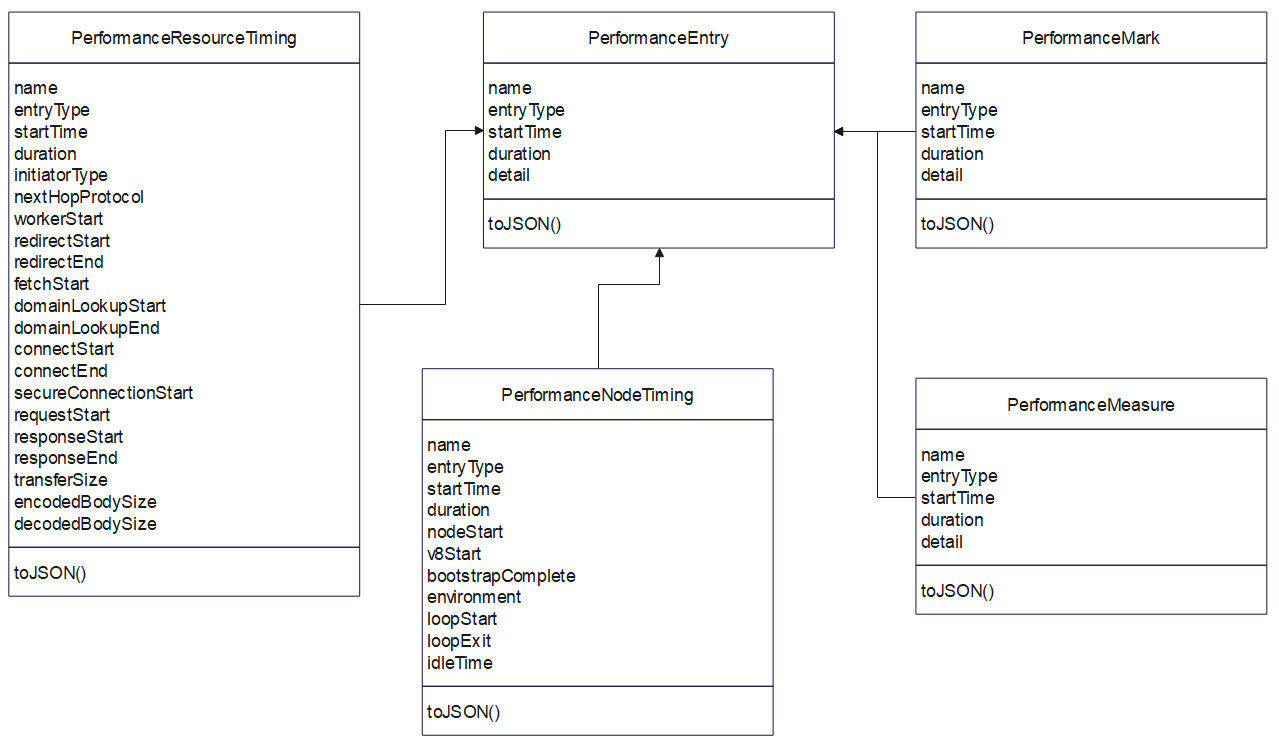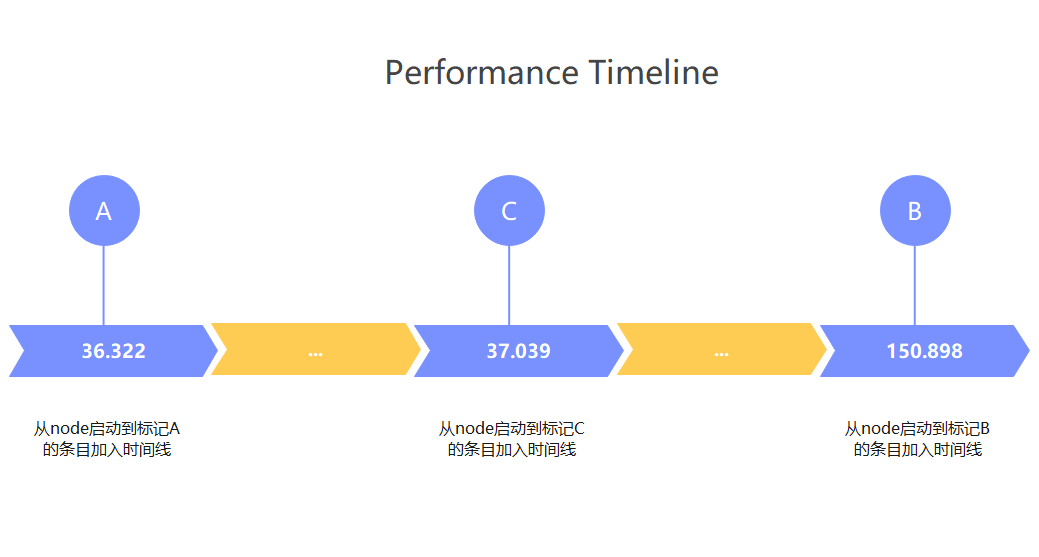Node.js 技术原理分析系列——Node.js 的 perf_hooks 模块作用和用法

Node.js 是一个开源的、跨平台的 JavaScript 运行时环境,它允许开发者在服务器端运行 JavaScript 代码。Node.js 是基于 Chrome V8 引擎构建的,专为高性能、高并发的网络应用而设计,广泛应用于构建服务器端应用程序、网络应用、命令行工具等。
本系列将分为 9 篇文章为大家介绍 Node.js 技术原理:从调试能力分析到内置模块新增,从性能分析工具 perf_hooks 的用法到 Chrome DevTools 的性能问题剖析,再到 ABI 稳定的理解、基于 V8 封装 JavaScript 运行时、模块加载方式探究、内置模块外置以及 Node.js addon 的全面解读等主题,每一篇都干货满满。
本文内容为本系列第 3 篇,由体验技术团队屈金雄原创。以下为正文内容。
前言
在 Node.js 中,如何测量一段代码的耗时呢?
比如 for 循环遍历 100 次的耗时。让我们带着这个问题,开始本文的讲解。
1.用 Date.now()
很容易就能想到,在循环前后分别取一个时间,再相减不就行了
运行多次后发现,结果永远是 0。原因是 Date.now() 只能精确到毫秒级别,无法用于计算零点几毫秒这种的耗时。
2.用 console.time() 和 console.timeEnd()
运行上述代码,在控制台打印:example: 0.179ms。 目的是达到了,但是这种方法仅适用于在控制台打印结果。如果要放到日志中,就不行了。
3.使用一些三方库
这样的三方库当然是有的,比如 benchmark.js 库,也能提供高精度时间戳。但问题就在于这些库是第三方的,如果 Node.js 本身的代码需要测试或记录性能数据,三方库就不再可用了。
在本文主角 perf_hooks 模块出现之前,还有更多的解决方案被采用,这里就不再列举。总之,我们需要 Node.js 自己的模块。 在 2017 年,也就是 node 8.5 版本发布时,就有了 perf_hooks 模块,用来提供高精度时间戳,测试代码耗时。
接下来我们探索一下,这个模块的用法。 由于 node 官方文档总是很简洁,很少写为什么,像字典一样。我们习惯性的全网搜索好心人提供的新手教程,但是这次失败了,关于 perf_hooks 介绍的文档很少。无奈之下,回到官方文档。
官方文档一开头就给出了一个示例:
相信初学的你和我一样,有十万个为什么想问
为什么用起来和我想象的不一样?
为什么要 new PerformanceObserver?
PerformanceObserver 是干什么的?
...
这时我们只有最后一招了,啃源码。其中过程与艰辛不表,只讲源码中啃出的结论,开头问题的解法会附在解说示例中。
本文使用的 Node.js 源码是 18.20.2。
运行原理
讲运行原理之前,我们得先明白三个基本概念,就像我们学习编程语言之前,会不会写代码不要紧,总得先把变量、函数、类和对象,这些基本概念先熟悉一下,才能学习语句、api 等。
三个基本概念
高精度时间戳
本章第一个示例就告诉我们,想要计算代码耗时,先得有高精度时间戳。
perf_hooks 模块使用的时间戳都是高精度时间戳,依赖的底层 api 是
process.hrtime(),单位是毫秒(ms),保留 14 位小数点,例如 35.87660002708435。与通常意义的时间戳不同,高精度时间戳表示从 Node.js 进程启动到记录时间,中间间隔的时长。例如
performance.now()返回的是 Node.js 进程启动到 now 方法执行时的时长。这种设计可以避免操作系统时钟对精度的影响,适合 Node.js 性能度量。
PerformanceEntry
其中的 entry 翻译为条目最合适。 PerformanceEntry 是 perf_hooks 模块用来表示单条性能数据的数据结构,它有四个子类分别是 PerformanceNodeTiming、PerformanceResourceTiming、PerformanceMark 和 PerformanceMeasure。
一般来说,开发者不需要直接操作这几个类。
下图是简化后的示意图,实际层级关系比图中更多。

Performance Timeline
Performance Timeline 这个关键词,在文档中出现了 17 次,但是并没有介绍它是什么。Web Performance API 关于 Performance Timeline 的介绍,看起来和 perf_hooks 的源码又不相符。所以,我们根据 perf_hooks 源码和官方文档,可以做个未论证的推论,方便我们建立基本认知。
推论:Performance Timeline 是一个全局的变量,类型是数组,数组元素是 PerformanceEntry 类型的对象。
运行原理讲解
理解了前面两个基本概念,运行原理就好讲了。可以自行脑补一下,内存中有个数组,称呼为 Performance Timeline,用于按时间顺序存放一条条的性能数据。
那么接下来,分别实现向 timeline 数组中写入、读取等能力,就可以基本满足这个性能模块的需求了,具体实现在后面的章节会讲。
接下来用一个示例进一步说明运行原理:
如上代码打印的时间数据,如下图:

可以看到打印了 A、B、C 三个条目的 startTime,对应的时间轴示意图如下图:

向 timeline 写数据
perf_hooks 直译是性能钩子。其实 hook 翻译为挂钩更为贴切。挂钩一端固定在软件系统上,至于挂钩上挂什么,由用户决定,总之挂的东西(代码)会被执行,执行时机由系统决定。那 perf_hooks 体系中的 hooks 具体是指什么呢?
性能数据(PerformanceEntry)分为 node、mark、measure、gc、function、http、http2 等几种类型。续接前文提到的挂钩,向 timeline 写数据,实际是在 node 系统上放置挂钩。除了 mark 和 measure,其他几种类型挂钩已经提前放好了(内置)。
mark 和 measure 对应的函数就是封装后的挂钩(包括了钩子函数和定义好的函数内容),它们可以搭配使用,测量指定两个挂钩执行的时间差,这个时间差可以称为自定义指标。准确来说 mark 挂钩(performance.mark)用来在指定代码位置收集执行时间等性能数据,measure 挂钩(performance.measure)用来计算两个挂钩的时间差。
简单来说,performance.mark('A')执行时,会创建一条 PerformanceMark(也是 PerformanceEntry 的子类)类型的条目,并写入 timeline;performance.measure('A')执行时,会创建一条 PerformanceMeasure(也是 PerformanceEntry 的子类)类型的条目,并写入 timeline。
从 timeline 查询数据
从 timeline 查询数据的方式有两种,一种同步方式,一种是异步方式。为避免查询 timeline 数据的代码本身,对性能造成影响,通常推荐的方式是异步方式。
同步方式查询
以下三个方法用于同步地从 timeline 查询性能数据,返回 timeline 完整数据或其子集。
performance.getEntries()performance.getEntriesByName(name[, type])performance.getEntriesByType(type)
如下两个示例中,查询代码是同步执行的,如果 timeline 上的性能数据过多,查询动作会明显阻塞主线程。
示例代码 1:
这个示例中, performance.mark('A')创建了一条 PerformanceMark 类型的数据,并添加到 timeline 中;performance.getEntries()取到当前 timeline 中的所有数据,它是一个数组,此时数组中只有一条数据;performance.getEntries()[0]取到第一条数据。
用 node test_perf_hooks.js 命令,运行这个文件,打印结果如下:
结果中 startTime 的值是从 node 进程启动到这条数据创建时的毫秒数;duration 表示时长,PerformanceMark 类型的数据不存在时长,值都是 0。
示例代码 2:
这个示例就解决了文章开头提出的疑问。缺点是示例中的查询是同步的。
performance.getEntriesByName('A to B')从 timeline 中查询出所有名称为'A to B'的数据,这里只有一条。 用 node test_perf_hooks.js 命令,运行这个文件,打印结果如下:
这条 PerformanceMeasure 类型的数据,表示标记 A 到标记 B 所用时长,这里 for 循环 100 次耗时是 duration 的值 0.14899992942810059。
异步方式查询
以下三个方法用于异步地从 timeline 查询性能数据,同样返回 timeline 完整数据或其子集。
performanceObserverEntryList.getEntries()performanceObserverEntryList.getEntriesByName(name[, type])performanceObserverEntryList.getEntriesByType(type)
如下两个示例中,new PerformanceObserver 是在创建观察者,其构造函数入参是一个等待触发执行的函数,当监听的指定类型的条目数据被创建时,构造函数入参会被触发执行。本节所谓的异步,就是指定义在构造函数入参中的查询动作,时异步执行的,无论查询耗时多长,都不阻塞主线程。构造函数入参的入参是性能条目列表。
示例代码 1:
最后一行的执行,触发new PerformanceObserver时入参函数的执行。
示例代码 2:
这个示例是本文开头问题的最优解。
运行后,打印结果:A to B: 0.15059995651245117,与其他几种的结果相符。
API 串讲
理解 Performance Timeline 是本模块的设计思想的关键所在。除了定义性能数据结构的 API,就是向 timeline 读写数据的 API。理解到了这一层,整个模块就算理解的差不多了。
一些使用场景及其示例
测量异步操作耗时
测量模块加载耗时
测量 HTTP 请求耗时
总结与回顾
文中推论,timeline 是一个全局变量,其实不准确,timeline 的准确构成和自动清除机制都存疑。但是这么理解能帮助我们快速建立对 perf_hooks 模块的基本认知。
下一节,将分享 使用 Chrome DevTools 分析 Node.js 性能问题,请大家持续关注本系列内容~学习完本系列,你将获得:
提升调试与性能优化能力
深入理解模块化与扩展机制
探索底层技术与定制化能力
关于 OpenTiny
欢迎加入 OpenTiny 开源社区。添加微信小助手:opentiny-official 一起参与交流前端技术~
OpenTiny 官网:https://opentiny.design
OpenTiny 代码仓库:https://github.com/opentiny
TinyVue 源码:https://github.com/opentiny/tiny-vue
TinyEngine 源码: https://github.com/opentiny/tiny-engine
欢迎进入代码仓库 Star🌟TinyEngine、TinyVue、TinyNG、TinyCLI~ 如果你也想要共建,可以进入代码仓库,找到 good first issue 标签,一起参与开源贡献~










评论